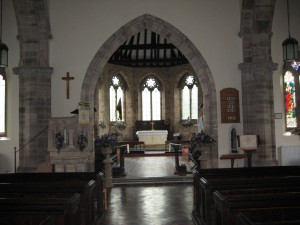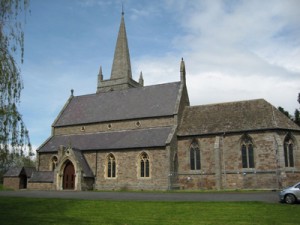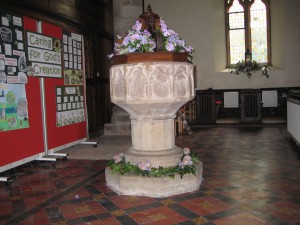This delightful church sits right on the banks of the river Lugg, and is clearly a much loved and well used part of the community.
In the 1850’s, when the Rev. H. Laing D.D. (ex Head Master of Hereford Cathedral School) was presented to the living, he found his house to be in a state of advanced dilapidation and set about building a new Vicarage near to the Church.
His next problem was the Church, which became extremely dangerous with decayed roof timbers and supporting pillars leaning alarmingly. The nave and aisles were dilapidated, and huge cracks had appeared in the walls – the west wall was found to have moved from vertical by a massive 2 ft 6 ins, and the clerestory walls had completely separated from the outside wall. It was realised that a restoration was just not feasible, and entire rebuilding was the only solution.
An appeal was set up, and £300 was raised, with a further agreement by the parishioners to raise a thousand pounds on a mortgage of the Church rates, to be paid off in 20 years.
The old 13th century church was pulled down, and rebuilt by Mr. Noden of Leominster; some materials and valuables were saved and adapted for use in the new church, such as the pillars and arches and the well and niche of St. Ethelbert. The work was not without incident. Mr. Noden suffered an accident which nearly claimed his life, and there were other problems and misfortunes; but eventually the work was completed and the new church was opened at the end of November 1860.
There is an interesting legend connecting King Ethelbert and the site of St. Mary’s church – it is recorded that he made the journey from eastern England to Marden in order to marry King Offa’s daughter, but it went rather badly wrong for him when he had his head cut off just outside the village! His body was left by the River Lugg, and the legend insists that on that spot a fresh water spring suddenly appeared.
King Offa was a bit taken aback by this and asked Pope Adrian I what he should do to make right the wrong he had clearly done – he was told to build a church on the site, and this he did. The spring was inside the church, and even though the present church is of course much older than 8th century, the spring, in the form now of a well, is still there.

Font
Both the font and church were decorated beautifully in honour of the Queen\’s Diamond Jubilee at the time of our visit.
Memorials
Mrs. Mary Wittingslow
Donation to this Parish 1838. Mrs. Mary Wittingslow of the parish of Marden in this County, left by Will the sum of £100, the duty of which having been paid, the interest of the remaining £90 is directed to be given to poor House Keepers of this Parish on the 8th day of July annually at the discretion of the Minister and Church Wardens of the said Parish

Organ
In October 1847 the new organ at Marden church was officially opened, and a large number of parishioners turned out for the event.
It was said that “the whole congregation appeared to glow with a desire to sing to the praise and glory of Him from whom all blessings flow”.
The organ was built by Bates of London, and paid for by Mr. Child to whom the parishioners of Marden felt very grateful, and indebted by his selection of such an instrument “of such power and sweetness of tone”


